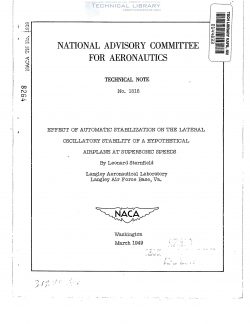naca-tn-1818
- Version
- 174 Downloads
- 1.52 MB File Size
- 1 File Count
- December 8, 2016 Create Date
- December 8, 2016 Last Updated
National Advisory Committee for Aeronautics, Technical Notes - Effect of Automatic Stabilization on the Lateral Oscillatory Stability of a Hypothetical Airplane at Supersonic Speeds

A theoretical investigation has been made to determine the effect
of automatic stabilization on the lateral oscillatory stability of a
hypothetical supersonic airplane. The investigation included an automatic
pilot sensitive to a displacement in either yaw or_roll and an auto—
matic pilot sensitive to either the yawing or rolling angular velocity.
The calculations were made for each type of automatic pilot acting inde—
pendently of the others. An idealized control system.without lag was
assumed for the calculations.
The results of the investigation indicated that all the automatic
pilots improved the stability of the original unstable short—period oscil—
lation. The only one of the automatic pilots which resulted in an oscilr
lotion that satisfied the NASA and military criterions for satisfactory
damping—period relationship, however, is an automatic pilot sensitive to
the yawing angular velocity and geared to the rudder so that rudder
control is applied in proportion to the angular velocity.
The lateral—stability boundaries calculated in reference 1 indicated
that for high—speed airplanes designed with high wing loadings and swept—
back wings more directional stability is required for oscillatory
stability than for an airplane with a straight wing and lower wing loading.
subsequent lateral stability investigations (references 2 and 3) showed
that the directional stability required for oscillatory stability may
be reduced if the principal longitudinal axis of the airplane is inclined
above the flight path. Additional, unpublished, dynamic—stability calcur
lations on the effect of an automatic pilot which gives control pro— '
portional to the angular displacement in either yaw or roll or an automatic
pilot which gives control proportional to either the yawing or rolling
angular velocity also indicated that the use of the automatic pilot permits
a reduction in the directional stability required for oscillatory stability.
These calculations for the effect of the automatic pilot Were made at
the time the theoretical investigation reported in reference 3 was carried
out, but the results of the calculations were not published then because
the stabilizing effect that would be obtained by inclining the principal
axis above the flight path was believed to be sufficient to obviate the
necessity of installing an automatic pilot. Recent lateral—stability
analyses of several airplanes have shown, however, that the oscillatory
stability is not satisfactory even when the principal axis is inclined
above the flight path. The use of an automatic pilot therefore offers
another means for improving the oscillatory stability.
| File | Action |
|---|---|
| naca-tn-1818 Effect of Automatic Stabilization on the Lateral Oscillatory Stability of a Hypothetical Airplane at Supersonic Speeds.pdf | Download |

Comment On This Post